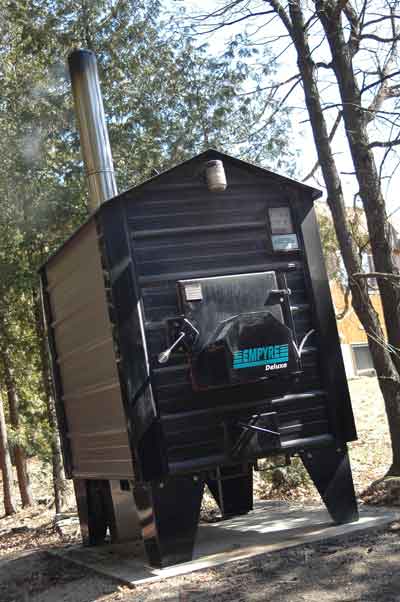 As each passing winter fades into spring, I’m reminded how we’ve been completely dependent for many months on energy for space heating here in Canada. From at least November until April some kind of heated space has been our essential life support system, and much of this is based on fossil fuels. Every additional winter that we rely on this stuff to stay alive brings us one year closer to the inevitable point when scarcity drives fossil fuel prices beyond the reach of affordability. Sustainable solutions to this simple yet stubborn reality are many and varied, and outdoor wood boilers are one option that you may not have heard of before. Although they aren’t for every situation, they are a sustainable home heating option that’s improved a lot lately. Here’s a close look at how outdoor wood boilers work, why they’re poised to become more popular, and some facts to consider as you decide if this technology is for you.
As each passing winter fades into spring, I’m reminded how we’ve been completely dependent for many months on energy for space heating here in Canada. From at least November until April some kind of heated space has been our essential life support system, and much of this is based on fossil fuels. Every additional winter that we rely on this stuff to stay alive brings us one year closer to the inevitable point when scarcity drives fossil fuel prices beyond the reach of affordability. Sustainable solutions to this simple yet stubborn reality are many and varied, and outdoor wood boilers are one option that you may not have heard of before. Although they aren’t for every situation, they are a sustainable home heating option that’s improved a lot lately. Here’s a close look at how outdoor wood boilers work, why they’re poised to become more popular, and some facts to consider as you decide if this technology is for you.
Wood Boiler Basics
All outdoor wood boilers look like a small metal garden shed with a short chimney. Feed wood into the firebox behind a door on one side, and the fire heats water in an insulated tank that’s also inside the structure. Pipe this hot water to a building through insulated underground pipes. This water can be used in:
- radiators
- infloor pipe networks
- the plenum of a forced-air duct system for space heating
- heating domestic hot water
By moving the fire outside, you sidestep the work of bringing firewood inside, the potential hazards of burning it there, and the work of hauling ash back out. Outdoor boiler technology also offers three other benefits: size, spread, environmentally friendliness.
Sometimes Size Matters
Although heating with wood isn’t practical everywhere, it does make sense in many parts of Canada. Outdoor boilers make woodcutting and splitting more efficient, because the work can happen right next to the place the wood will be burned. The fireboxes on most wood boilers are larger than you’ll find on even the largest indoor woodstoves, and this means less time spent cutting and splitting logs. The smallest outdoor boiler can accommodate wood 20 inches long, while many larger models burn wood twice that long. Longer wood makes for less cutting time and more efficient use of your wood splitter.
Heat Delivered to Multiple Places
Large heat output is another unique feature of outdoor wood boilers, and this offers what may be the greatest efficiency of all if you’ve got several buildings to heat. Even the smallest models are capable of heating a full-size home, with larger units heating multiple buildings as well as domestic water. The work of tending one centrally located outdoor fire is safer and easier than maintaining two or three fires.
Environmentally Friendly Improvements
The important news about outdoor wood boilers is that they’re moving beyond their well-deserved reputation for dirty combustion. Traditional outdoor boilers often belched smoke like a steam locomotive, but that’s changing. Gasification technology allows today’s cleanest wood boilers to burn virtually smoke-free, with clean performance independently verified to meet EPA Phase 2 emissions output. This means they’re at least 90% cleaner than older style models that created the reputation for dirty combustion in the first place. See www.epa.gov/burnwise/woodboilers.html for more on outdoor wood boiler combustion standards and a list of qualified manufacturers producing the new clean burning models.
As with all biomass heating systems, outdoor wood boilers are carbon neutral. This means they don’t contribute to the greenhouse effect. The carbon released in the exhaust was destined to return to the atmosphere whether the wood was burned or allowed to rot in the forest. This is why wood heat is widely recognized as making no contribution to greenhouse gas emissions, and it’s one way that some of us Canadians can move beyond the numbered days of our fossil fuel life support system.


